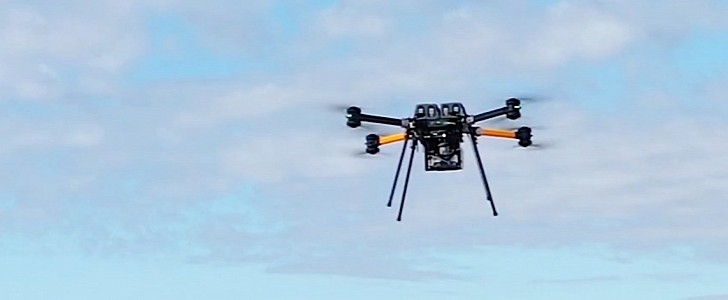Chicken is a word that describes a lot of things. For the purposes of this piece here, it means that dare game that sees two vehicles heading straight for each other, just to see who dodges first.
We’ve seen this idea being put in practice in countless movies, and perhaps even in real life, but such a thing seldom happens anywhere else than on the ground. These guys, engineers from American company Honeywell, tried to make it happen in the air, as they were evaluating a new radar system called IntuVue RDR-84K.
IntuVue is a piece of technology that should allow airborne assets to see and avoid noncooperating traffic – that would be flying objects that do not use transponders conventional detection systems can see.
It was put to the test recently by Honeywell somewhere near Phoenix, being fitted on a quadcopter in a “high-stakes game of dodgeball” against a similar drone that acted as the intruder.
The two drones were flown directly at each other at an altitude of 300 feet (91 meters). As you can see in the video here, the noncooperating drone won the game of chicken, as the IntuVue system fitted on the other one kept getting it out of the way.
That’s not a fluke, of course, but exactly what the system was designed to do: detect dangers, take over the aircraft, and automatically and autonomously move it out of the way.
The system had already been tested by Honeywell on helicopters and drones, but this was the first time it got to use its avoidance feature. So, for this quadcopter to have lost the game of chicken was on purpose and what the team was after.
IntuVue weighs less than two pounds (almost one kg) and measures eight inches wide and four inches high (20 cm by 10 cm). It has no moving parts and uses monopulse technology to see targets as far as three km away (1.9 miles).
When ready for the market, it should become essential to the “adoption of self-flying aircraft, drones and advanced air mobility vehicles.”
IntuVue is a piece of technology that should allow airborne assets to see and avoid noncooperating traffic – that would be flying objects that do not use transponders conventional detection systems can see.
It was put to the test recently by Honeywell somewhere near Phoenix, being fitted on a quadcopter in a “high-stakes game of dodgeball” against a similar drone that acted as the intruder.
The two drones were flown directly at each other at an altitude of 300 feet (91 meters). As you can see in the video here, the noncooperating drone won the game of chicken, as the IntuVue system fitted on the other one kept getting it out of the way.
That’s not a fluke, of course, but exactly what the system was designed to do: detect dangers, take over the aircraft, and automatically and autonomously move it out of the way.
The system had already been tested by Honeywell on helicopters and drones, but this was the first time it got to use its avoidance feature. So, for this quadcopter to have lost the game of chicken was on purpose and what the team was after.
IntuVue weighs less than two pounds (almost one kg) and measures eight inches wide and four inches high (20 cm by 10 cm). It has no moving parts and uses monopulse technology to see targets as far as three km away (1.9 miles).
When ready for the market, it should become essential to the “adoption of self-flying aircraft, drones and advanced air mobility vehicles.”






